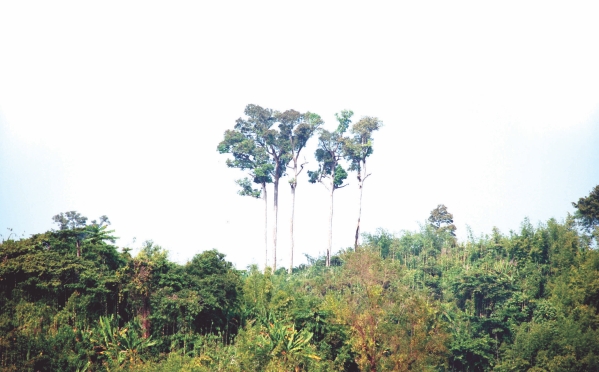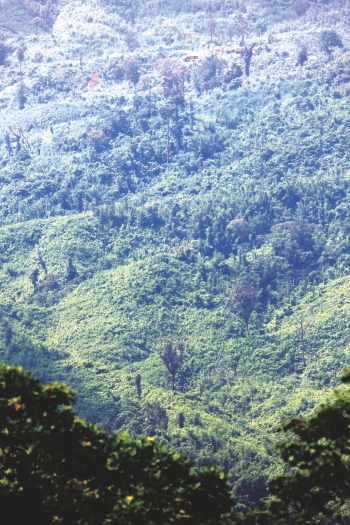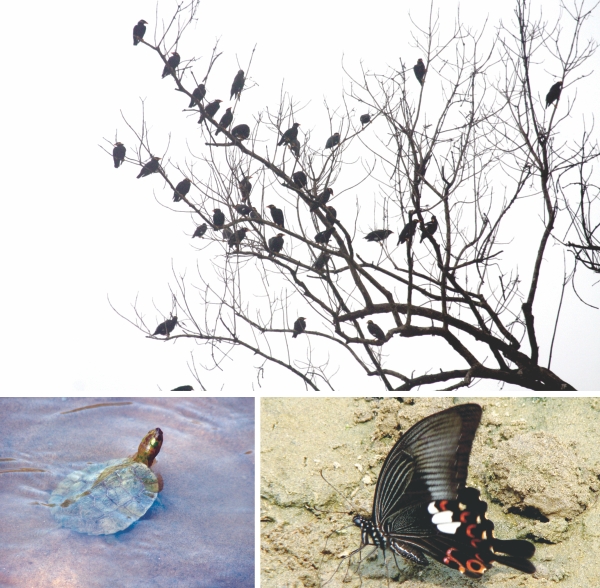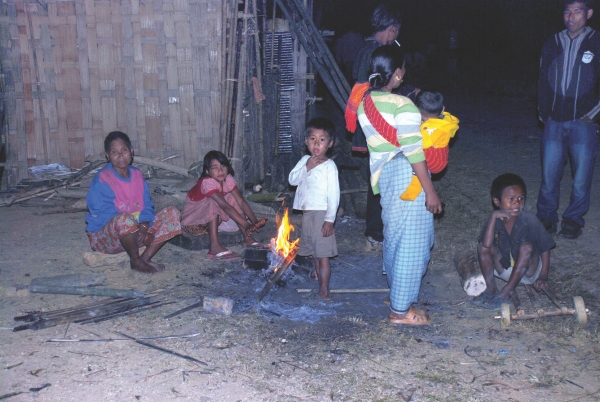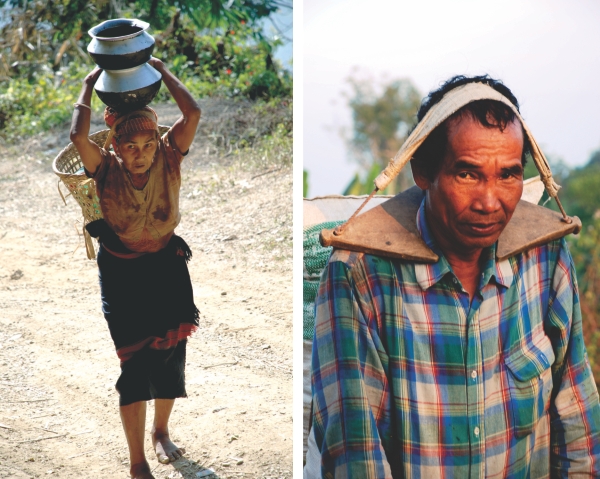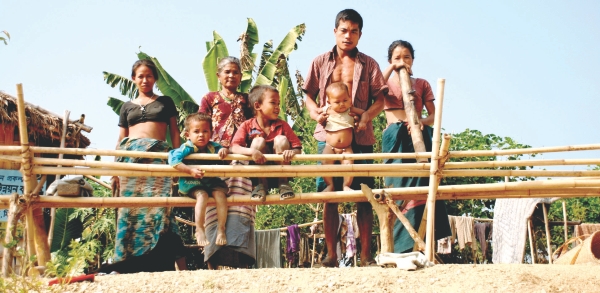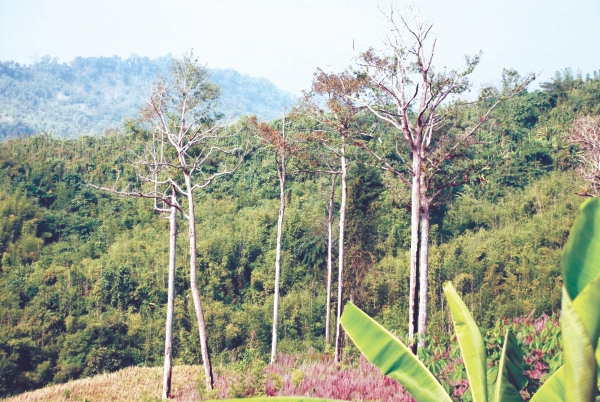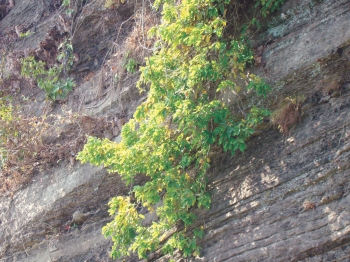| Home - Back Issues - The Team - Contact Us |
 |
| Volume 10 |Issue 38 | October 07, 2011 | |
|
|
Cover Story
Heaven in the Hills The Chittagong Hill Tracks is no doubt one of the most alluring spots of the country. Deep within the hills lies a valley called Sajek that holds many a hidden treasure of nature. A group of nature lovers take an eco tour to this luscious valley to unravel its wondrous mysteries that have survived despite the continuous assault of humans. Dr Anisuzzaman Khan Photos: Asaduzzaman Khan Sajek – a valley surrounded by high hill ranges of evergreen forest along the border of Bangladesh and India at southeast, is known as the Roof of Bangladesh. As far as biodiversity is concerned, it is one of the unexplored areas. Inspired by Dr Reza Khan, a wildlife expert and the curator of the Dubai Zoo, who had visited the valley earlier, we were tempted to explore the wilderness of the site. Accordingly we formed a team on behalf of a TV documentary entitled “Nature and Life” of Channel i to lead a nature expedition at Sajek Valley. It was the winter of 2010 amidst foggy and chilly weather when we cruised to the valley by a four-wheel drive Toyota land cruiser. Our carrier was locally known as “Chander Gari” which means a car that can cruise even the rugged surface of the moon! We boarded the rented vehicle from Baghaihut, the place where we left our posh Toyota Hiace micro-bus; posh cars are not meant to run on the bumpy roads with countless sharp bends. Some of us went to the roof of the jeep to get a better view of the hills and take shots of the hillscapes and the wildlife passing on our way. The road was spiral and bordered with lush evergreen forest.
Atop a hill we could get a great view of the surroundings as far as the eyes could see. All around us were undulating hill ranges covered with some form of greenery. Although the virgin natural forest is no more a secondary growth, herbs and shrubs are in abundance. Some of the hill sides and slopes are covered with dense bamboo thickets of more than seven species. The Hill streams ran gradually to the gorges with steeper banks. All these small hill streams joined together and formed rivers - Kasalong, Mainy, Sangu and Matamuhuriy rivers that originated and merged towords the sea within the territorial boundary of the country. A few mother trees reaching high up in the sky formed the symbol of a lost forest. These were kept by the forest department as genome refuse. Hill mynas called out in loud whistles while flying from one place to other. They were large groups varying from 5 to 100 in number. Possibly this was the only place where you could encounter such large flocks. Similarly, you could encounter the Chestnut-headed bee-eater in hundreds, either perching on denuded hill edges or congregating on a single tree singing a high-pitched chorus. It was winter but we still got thirsty with the hectic climb. We got down in a valley and drank from an old stream with our bamboo pipes, our local guide had instantly made by cutting the tender bamboos from the bush. This is the traditional way of drinking stream water; it is also the safe and easy way. The water was heavy and sweet enough to quench our thirst. It was running slowly and looked transparent with a bluish reflection. You could see the hill shrimps, mollusks, water bugs and tiny fish with your naked eyes in the crystal clear water. There were stones of various sizes and shapes all along the stream. Smaller stones and pebbles were rolling down while the larger and heavier ones stood still. The people of the Hill revered these huge stones. They prayed, lit candles and offered sweets and fruits on the boulders. Dr Khan was looking at the crevices and cracks of the heavy boulders and all of a sudden he shouted to us to go to him. We all rushed to him and were amazed to see the tiny and brilliantly coloured frogs known as “Assam Cascade frog/Beautiful Stream frog” mimicking the damp mosses and bryophytes. The frogs were so well camouflaged with the environment that it was almost impossible to see them unless they moved! The tiny frogs croaked very loudly. While walking at knee deep streams, we also saw Ornate Microhylid and Berdmore's Narrow-mouthed Frogs. All of them were happily living in the hill streams and hunting the small insects, beetles and crickets.
On the wet walls of the stream we saw the shiny skinks where the hanging grasses and lichens were dense. In one bend of the stream the hanging plants, climbers, vines and tree ferns were very dense. We were crawling to cross the cave-like entrance; suddenly we noticed a pair of White-crowned Forktails – quite beautiful birds. These birds are mostly stream dwelling and prefer dense forested cool and shady places. Their tail is bifurcated and very sharply forked. They were seen dancing on the rocks rolling in running water and feeding on the fish and insects of the hill stream. We reached the hill top of our dream Sajek valley in the afternoon where the Mizo, Lusai and Tippera villages were located. The Headman Lanthanga Lusai welcomed us with local drinks and homemade cakes. We literally dumped our luggage in the compound of the headman and rushed to the nearby hills as the light was perfect for photography and we didn't want to miss this rare opportunity.
At the doorsteps of the Church at a hill top we were met by a huge old Banyan tree. We spotted more than 50 Hill Mynas there. They were feeding on the ripe yellow fruits of the tree hanging upside down. I had never seen the Hill Mayans in the wild at such close range in my 20 years of nature watch around the world. The area was really lively with the chorus of Mynas and the surroundings illuminated with the vibrant colours of the delightful birds. There were few other old and tall Bombax trees bearing red flowers on the nearby hills. Birds moved around these trees enjoying their meals. We were hypnotised with the rhythmic calls and flights of Mynas over the colourful plants waving around the Sajek valley. Our camera unit was initially dazed watching the Mynas whirlpool but later they were able to get some clear and good shots of the flights and feeding behaviour of the bird flocks. Together we watched their fascinating feeding habits the whole evening. Some barbets and parakeets were also seen feeding in association with Mynas. We noted all possible ecological features of the habitat including vegetation canopy, eco-tones, species assemblage and diversity etc. We were very tired and walked hurriedly to our host's house hanging on the hills. Wagain Fu, the elder daughter of the headman, looked a bit upset and finally in a low voice commented accusingly “now that you're so late you have to have your meal cold”. But the dinner cooked by our host family was simple and delicious. The menu consisted of had boiled leaves of wild plants with no oil and less spice, green chilli paste, wild cucumber and vegetable, green salads and smashed dried fish.
Dr Reza introduced us to the headman's family and explained the purpose of the trip. The headman was very friendly, and well-known to Dr Khan who showed pictures of the headman's family members and the natural beauty of the areas he had taken on a previous trip. All the members of the family along with the invited community leaders enjoyed seeing the pictures of colourful images of the lovely birds. Wagain Fu offered all of us specially prepared beetle nuts as a symbolic good night. After gossiping till midnight with the headman and his family, we being the guests occupied the drawing room space which is a wide wooden floor with two doors and two windows. Our hosts offered warm blankets but we returned them with our thanks as we were well equipped with winter clothes and sleeping bags. We made a sleeping row in the style of “Jatra performers” and blessed our creator for having given us such shelter in the remotest hills of Bangladesh. At night we heard the wild calls of Nightjar, owls, croaking of tree frogs, Barking Deer's and loud 'tokkey' of Takhkhak, the forest Gecko.
We got up at around six in the morning with the smell of Mizoram coffee boiling in the earthen oven, fuelled by locally collected firewood. The lady of the house offered us hot coffee with fried maize. Dr Reza got up earlier than the rest of us and went on morning bird watch walk and told us that Hill Myans' were also having their breakfast in the old banyan and fig trees with a background music of a dawn chorus joined by Leafbirds, sunbirds, bulbuls, orioles, iora and barbets. He asked us to join them and photograph them because the morning sun shined for a while despite the foggy sky. All the team members were ready by 7 am and under the guidance of Dr Reza khan started to move to the Banyan tree. As we walked through the hill slopes, we saw sparkling dew on the grass blades. A pack of pariah dogs were barking and started chasing us taking us for intruders. The dogs here are shorter and jet black in colour, which is totally different from the plain land ones. According to the locals these dogs are raised to be consumed in Mizo style. We followed Dr Khan and on our way explained to us forest ecosystems, the linkage of wildlife with the plants. He also helped us identify different species of wildlife, and even some of the insects. We encountered some rare and interesting animals. In a shallow water pool deep in the forest we found a breed of small leaf turtles. This turtle is very cute and resemble a dead leaf. A flock of rare dollar birds was seen in the upper canopy of Sajek forest.
In Avifauna of Sajek valley we had recorded 140 species of birds. Important sightings are: Rufous-throated Hill Partidge, Khalij Pheasant, Great Slaty Woodpecker, Great Pied Hornbill, Dollar bird, Bengal Coucal, Vernal Hanging Parrot, Forest Eagle Owl, Hogson's frogmouth, Great Eared Nightjar, Imperial Pigeon, Steppe Eagle, Fairy Bluebird, Green Magpie, Himalayan Treepie, Greater Racket-tailed drongo, White-collared Blackbird, Large Nilvata, Sapphire Flycatcherand Spotted Forktail. Following an animal trail, we walked north. The trail is used by barking deer and wild boars. We carefully checked the footprint and pugmarks on our trail and noted the presence of wildlife inhabiting there. We found indices of jungle cats, Large Civet, Hispid hare and Goat Antelope. Among the large mammals the footprints of Sambar, Wildlboar and Barking deer were seen very prominently along the bank of the hill streams. The indices such as faecal matter, scratches on the tree barks, remnants of foods eaten and resting signs were recorded. On our walk we saw two Orange-bellied Himalayan Squirrels. The valley is a good abode of primates and we saw groups of Assamese Macaque, Stump-tailed Macaque and Rhesus Macaque. According to the local guides a few gropes of Spectacled/Phayre's Leaf Monkeys and Capped languor live in this valley. They are also occasionally encountered by the Clouded Leopard, Leopard cat, Hog badger and Binturong. According the forest dwellers, these wild animals were seen on rare occasions in the valley but due to over-hunting, their numbers had reduced to an alarming state. Local people are very fond of hunting and trapping the wild animals.
There were several indigenous hunting traps, harpoons and guns for hunting. They informed us that only a month back people hunted a wild goat from the hills of Sajek. People also hunt snakes and other reptiles. The valley was once famous for its elongated land tortoise. At present it is very hard to find a single specimen from the valley though. Local people used to meet their protein needs mostly from wildlife of the forest. There are enormous varieties of beetles, bugs, spiders, centipedes, millipedes in the valley and butterflies are seen at various layers of ecosystem profile. We collected some samples of rare plants which we failed to identify in the field. The herbarium sheets will be referred to National herbarium for proper identification. In the afternoon, we started to climb one of the high hills to collect more information for our documentary. We saw a good number of epiphytes and orchids on the steep wall of the rocky mountains. Climbing this part of the hills is very tough as there exists no walkway or trail. People usually do not visit this side of the hill; as a result, the area remains undisturbed and we were able to see rare species of bats, blackbirds, skinks and butterflies. The wall of the hills was covered with thick mats of moss, thallophytes, and lichens. Sometimes we would hang on the vines and jump from one edge of the hill to the other to avoid falling on the slippery slopes. Despite the consumption of plants and poaching of wildlife by the local community, Sajek valley is still one of the last repositories and reservoirs of forest biological diversity. Chittagong hill districts are the last refuge of evergreen forest biodiversity in Bangladesh. Only three decades ago the area was a contiguous forest cover and abode of flagship wildlife like tiger, elephant, deer, leopard and bear. Some areas were impenetrable and dense. Only few indigenous people were dwelling deep inside the forest. Commercial tree plantations, illegal logging, mega dam projects and forced displacement are responsible for the accelerated destruction of these precious ecosystems, which means the destruction of their biodiversity. Rubber, Teak Acacia and Eucalyptus monocultures have provoked negative ecological effects by the substitution of part of the forest, as well as conflicts between local communities belonging to the 13 indigenous groups that inhabit the region and the Forest Department. Massive cultivation of tobacco in the productive hilly lands is another reason behind the destruction of the forest. Once the hill forests were abundant with numerous plant as well as animal species; an estimated 2000+ species of angiosperm were reported from Chittagong region alone. In Sajek valley the top canopy of the forest ranges from 30 to 50 m in height and usually comprises various species of Garjan (Dipterocarpus sp.), Chapalish (Artocarpus chaplasha), Civit (Swintonia floribunda), Telsur (Hopea odorata), Buddah Narikel (Pterygota alata) etc. The second storey ranges between 15 and 25 metres in height and the tree species are Jam (Syzygium sp.), Rata (Amoora wallichi), Tali (Palaquium polyanthrum), Kamdeb (Callophyllum polyanthum), Uriam (Mangifera sylvatica), Jarul (Legarstromia speciosa), Nageshwar (Mesua ferrea), Raktan (Lophopetalum wightianum), Gamar (Gmelina arborea) etc. The third storey ranges from 1 to 15 metres and comprise saplings of species of upper two canopies as well as Vitex glabrata, Saraca Indica, Mollotus philippensis, Macaranga Sp., Castanopsis Indica, Cordia Myxa etc. Moreover there are bamboos, canes, climbers and fern also grow as undergrowth in these forests. Diversity in species of plants and the natural settings of canopies are heavily lost in the hill forest especially in Sajek valley, causing enhanced landslides, decreasing soil fertility, siltation of hill streams and rivers and drying up of streams, extinction of plants and wildlife and enhanced poverty and ecological disasters in the hill regions. Apparently Sajek and its neighbourhood are parts of a privately managed forest system on which the government's forest department has very little control. So, all commercially viable trees have been felled by the local ethnic groups who own the land and the forest, as has been done by the forest department in the government reserves. As these people are still great hunters and get almost all their protein needs from the animals they have wiped out all larger mammals and birds, while smaller animals are flourishing. The non commercial plants have survived the onslaught on timber trees. This has given rise to a unique biodiversity that is found nowhere else in the country.
The writer is a biologist and wildlife expert.
Copyright (R) thedailystar.net 2011 |
||||||||||||||
